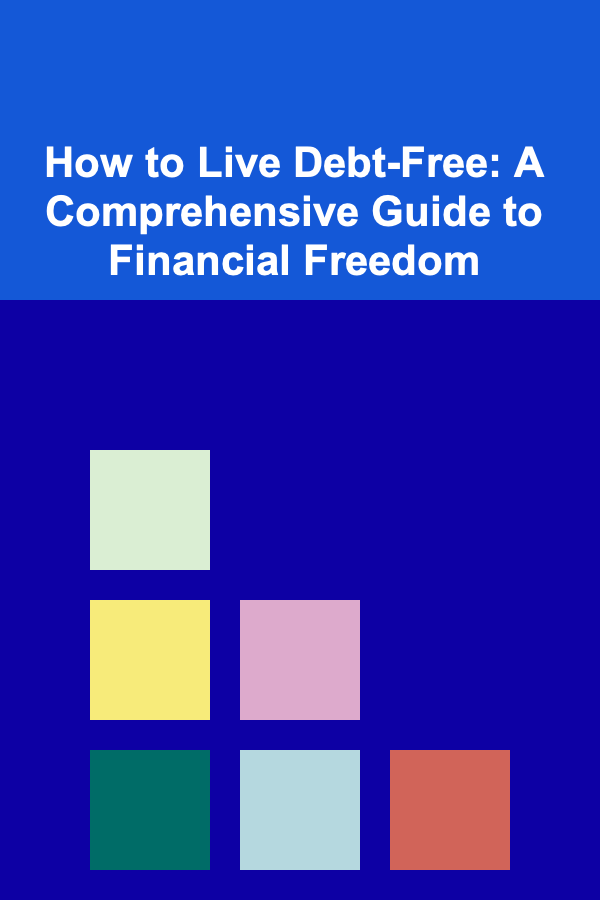
How to Live Debt-Free: A Comprehensive Guide to Financial Freedom
ebook include PDF & Audio bundle (Micro Guide)
$12.99$8.99
Limited Time Offer! Order within the next:

Debt is a word that weighs heavily on many people's minds. It's easy to fall into the trap of borrowing, whether it's student loans, mortgages, credit cards, or personal loans. While some debt can be a useful tool in building a future (such as a mortgage or student loan), living with debt can feel suffocating. For many, the goal of achieving financial freedom---living debt-free---seems like an elusive dream. However, it's a reality that can be achieved with discipline, planning, and a solid understanding of personal finance. In this comprehensive guide, we will walk you through the steps you can take to live debt-free and achieve financial independence.
Understanding the Importance of Living Debt-Free
Living debt-free means that you do not owe anyone money---whether it's credit card companies, lenders, or any financial institution. It offers financial freedom, peace of mind, and control over your own financial destiny. Here's why it's essential to work towards becoming debt-free:
A. Stress Reduction
Debt is a major source of stress for many individuals and families. Whether it's worrying about making payments or dealing with creditors, debt can create significant emotional strain. Becoming debt-free eliminates this source of stress and can significantly improve mental health and well-being.
B. Financial Security
Living debt-free enhances your financial security. You are not tied to monthly obligations that could put a strain on your finances. Without debt, you can invest more in savings, retirement funds, and other wealth-building opportunities. This creates a cushion for emergencies and a stable financial foundation for the future.
C. Freedom to Make Choices
When you're living debt-free, you have more flexibility in making life choices. Whether it's changing careers, taking time off, or traveling, you aren't confined by financial obligations. Debt-free living provides the freedom to live life on your terms.
Understanding the Types of Debt
Not all debts are created equal. Some debts are more damaging than others. Understanding the different types of debt will help you prioritize which debts to pay off first.
A. Secured Debt
Secured debt is a type of debt that is backed by an asset, such as a mortgage or car loan. If you default on this debt, the lender can seize the asset to recover the money. Secured debts tend to have lower interest rates because they are less risky for lenders.
B. Unsecured Debt
Unsecured debt, such as credit card debt, medical bills, or personal loans, is not backed by an asset. These types of debt often come with higher interest rates because the lender has no collateral to claim in the event of default. Unsecured debt can be the most difficult to manage, as it often accumulates rapidly.
C. Revolving Debt
Credit cards are an example of revolving debt, where you can borrow up to a certain limit, repay the debt, and borrow again. Revolving debt can easily spiral out of control due to high-interest rates and minimum payment requirements that barely reduce the principal balance.
D. Non-revolving Debt
Non-revolving debts, such as student loans, mortgages, and personal loans, have fixed repayment schedules and cannot be re-borrowed once they're paid off. While these types of debt may be necessary for certain life events (such as buying a home or financing education), they can still weigh heavily on your finances if not managed properly.
Creating a Debt-Free Plan
The journey to living debt-free starts with a plan. A well-thought-out strategy will provide structure and discipline to your finances and help you stay focused. Here's how to create a debt-free plan:
A. Track Your Expenses
Before you can begin tackling your debt, you need to understand your spending habits. Track all your expenses for at least a month. Categorize your spending to see where your money is going and identify areas where you can cut back. The goal is to free up as much money as possible to pay off your debt.
B. Calculate Your Debt
Make a list of all your debts, including the outstanding balance, interest rate, and minimum payment for each. This will give you a clear picture of how much you owe and help you prioritize which debts to pay off first. Include both secured and unsecured debts in this calculation.
C. Build a Budget
A solid budget is critical for living debt-free. Once you know your expenses and debts, build a budget that focuses on cutting unnecessary costs and putting any extra money toward debt repayment. Stick to this budget every month, and adjust it as needed to stay on track.
D. Set Realistic Goals
Set clear, achievable goals for your debt repayment. Break down your larger debt into manageable chunks, and set deadlines for paying off each portion. Celebrate small victories along the way to stay motivated.
Strategies to Pay Off Debt
Once you have a clear understanding of your financial situation, it's time to tackle your debt. There are various methods for paying off debt, each with its advantages and disadvantages.
A. Debt Snowball Method
The debt snowball method is one of the most popular strategies for paying off debt. Here's how it works:
- List all your debts in order from smallest to largest.
- Make minimum payments on all debts except the smallest one.
- Put as much money as possible toward the smallest debt until it is paid off.
- Once the smallest debt is paid off, move on to the next smallest, and continue this process until all debts are paid.
The snowball method is effective because it offers quick wins. Paying off smaller debts quickly builds momentum and motivates you to keep going.
B. Debt Avalanche Method
The debt avalanche method focuses on paying off high-interest debts first. Here's how it works:
- List all your debts in order from highest to lowest interest rate.
- Make minimum payments on all debts except the one with the highest interest rate.
- Put as much money as possible toward the high-interest debt until it is paid off.
- Once the highest-interest debt is paid off, move on to the next one with the highest interest rate.
The avalanche method saves you more money in interest over time and can be faster than the snowball method, but it may take longer to experience the psychological benefit of paying off a debt.
C. Balance Transfer and Consolidation
If you have high-interest credit card debt, consider using a balance transfer or consolidating your debts. A balance transfer allows you to move your high-interest debt to a credit card with a lower interest rate, potentially saving money on interest. Debt consolidation combines multiple debts into a single loan with a lower interest rate, making it easier to manage.
D. Cut Back on Spending
To pay off debt faster, you may need to make sacrifices in your lifestyle. Cutting back on spending will free up more money to put toward your debt. Focus on essential expenses and consider postponing discretionary purchases. Look for ways to save money in all areas of your life, from groceries to entertainment.
Build an Emergency Fund
While paying off debt is essential, it's also crucial to have an emergency fund. Unexpected expenses, such as medical bills or car repairs, can derail your debt-free journey if you don't have savings to fall back on. Aim to build an emergency fund of at least three to six months' worth of living expenses. This will provide a safety net and prevent you from accumulating more debt when unexpected costs arise.
Avoid New Debt
One of the biggest challenges of living debt-free is resisting the temptation to take on new debt. Here's how to avoid accumulating more debt:
A. Stop Using Credit Cards
Credit cards can quickly lead to debt if not used responsibly. Consider freezing or cutting up your credit cards to avoid impulse purchases. If you need to use a credit card, pay it off in full each month to avoid interest charges.
B. Live Below Your Means
Living below your means is key to avoiding debt. Resist the urge to keep up with societal pressures or spend beyond your means. Focus on saving and investing, rather than spending on things that won't add value to your life.
C. Build Good Financial Habits
Creating good financial habits is essential to staying debt-free. Pay bills on time, save regularly, and track your spending. Make smart financial decisions that prioritize long-term stability over short-term gratification.
Embrace Financial Education
Financial literacy is a critical component of living debt-free. The more you learn about managing money, budgeting, and investing, the better equipped you'll be to make smart financial decisions. Educate yourself through books, online courses, and financial blogs. Seek advice from financial experts, and don't hesitate to ask for help if needed.
Conclusion
Living debt-free is achievable, but it requires effort, discipline, and a commitment to making smart financial choices. Start by understanding your debt, creating a debt-free plan, and using proven strategies to pay off what you owe. Build an emergency fund, avoid new debt, and embrace good financial habits. With time, dedication, and the right mindset, you can live a debt-free life, achieve financial freedom, and enjoy the peace of mind that comes with it.

How to Create a Workflow for Managing Mail
Read More
How to Maintain Your Roof to Avoid Costly Repairs
Read More
How to Organize Your Dining Room for Family Gatherings
Read More
How to Participate in a Homestay Program Successfully
Read More
Feng Shui Your Living Room: Creating a Welcoming Space
Read More
How to Control Portion Sizes Effectively
Read MoreOther Products

How to Create a Workflow for Managing Mail
Read More
How to Maintain Your Roof to Avoid Costly Repairs
Read More
How to Organize Your Dining Room for Family Gatherings
Read More
How to Participate in a Homestay Program Successfully
Read More
Feng Shui Your Living Room: Creating a Welcoming Space
Read More